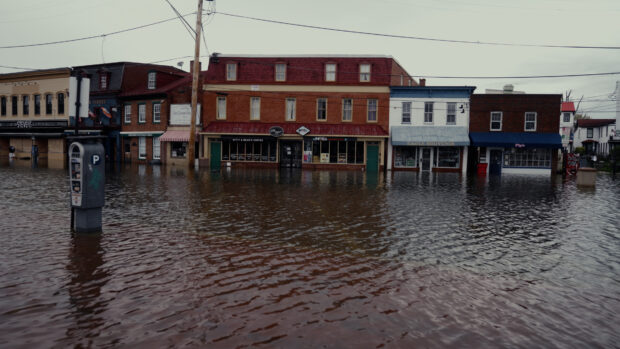After record-breaking coastal flooding, NOAA scientists predict La Nina could slightly reduce the number of flood days across the U.S.
NOAA’s 2024-25 Annual High Tide Flooding Outlook documents high-tide flooding events from May 2023 to April 2024 at 97 NOAA tide gauges along the U.S. coast.
The report also provides a flooding outlook for the locations through April 2025, accompanied by decadal projections and sea level rise scenarios out to 2050.
High tide flooding, sometimes referred to as “nuisance” or “sunny day flooding,” is increasingly common due to long-term sea level rise, driven in part by climate change, NOAA explained. It occurs when tides reach 1 to 2 feet above the daily average high tide, depending on location.
As sea level rise continues, it no longer takes severe weather to cause flooding along the coast.
“NOAA’s high tide flooding outlook is critical to the nation’s communities as they build their climate resilience,” said Jainey Bavishi, assistant secretary for oceans and atmosphere and NOAA deputy administrator. “The increase in high-tide flooding has affected infrastructure in coastal communities across America, especially in underserved communities.”
Summary of high-tide flooding in 2023-2024
U.S. coastal communities in 34 locations broke or tied their records for high-tide flood days in 2023 — a dramatic increase compared to just eight stations having done the same during 2022, NOAA analysis showed.
For the East and West coasts, a strong El Nino further compounded the effects of long-term sea level rise, worsening flooding impacts across those regions. Along the coastal Southeast, Charleston, South Carolina, observed 17 flood days.
Along the East Coast, Atlantic City, New Jersey, recorded its highest number of flood days at 26, a large increase from eight days in 2022, while the station at The Battery, in New York, measured 24 days.
On the Gulf Coast, St. Petersburg, Florida, observed six flood days, its highest number on record, while Galveston Pier, Texas, saw 23 days, an increase from eight flood days in 2022, the report showed. For the West Coast, San Diego observed 12 flood days — one day shy of its 2022 record.
The 2024-2025 High Tide Flooding Outlook
Between May 2024 to April 2025, NOAA predicts the U.S. will experience a median range of 4 to 8 high-tide flood days — slightly fewer than last year’s predicted 4 to 9 days — as El Nino conditions transition into La Nina.
Communities along the Pacific Islands and the western Gulf Coast are predicted to experience the most high-tide flood days, ranging between 5 to 16 days and 7 to 15 days, across the respective regions.
The Pacific Islands now experience a median of seven more high-tide flood days compared to the year 2000, a more than 250 percent increase, while the western Gulf experiences eight median high-tide flood days — a nearly 300 percent increase since 2000, the weather agency reported.
In addition, NOAA predicted an above-normal 2024 Atlantic hurricane season, which increases the chance of significant flooding along the Atlantic and Gulf coasts.
Although hurricane predictions are not factored into the high-tide flooding outlooks provided here, storm surge can lead to even higher water levels and cause additional flooding days or more substantial flooding impacts.
The shift to La Nina will be more noticeable along the West Coast as high-tide flooding in the region was largely driven by El Nino conditions rather than sea level rise.
For the Pacific Northwest, up to seven flood days are predicted; for the Pacific Southwest, up to three days, NOAA said.
Due to long-term sea level rise, the U.S. now experiences an additional five median flood days per year compared to 2000 — an estimated 200 percent increase.
By 2050, the nation is expected to experience an average of 45 to 85 high-tide flooding days per year. Long-term projections are based on the ranges of expected relative sea level rise of about a foot, on average, across the United States by 2050.
In addition to the Annual High Tide Flooding Outlook, NOAA provides a Monthly High Tide Flooding Outlook. The near-term outlook delivers high-tide flooding likelihoods for each day of the year — up to a year in advance — and provides predicted time ranges with increased flooding risks.





















 Aon Adds to List of Brokers Suing Howden US for Alleged Poaching, Theft
Aon Adds to List of Brokers Suing Howden US for Alleged Poaching, Theft  Unpacking a Consumer Intervenor’s Novel Idea
Unpacking a Consumer Intervenor’s Novel Idea  The Future of Knowledge in Insurance: From Training to AI-Powered Productivity
The Future of Knowledge in Insurance: From Training to AI-Powered Productivity  Truckers Who Fail English Tests Are Pulled Off Roads in Crackdown
Truckers Who Fail English Tests Are Pulled Off Roads in Crackdown 